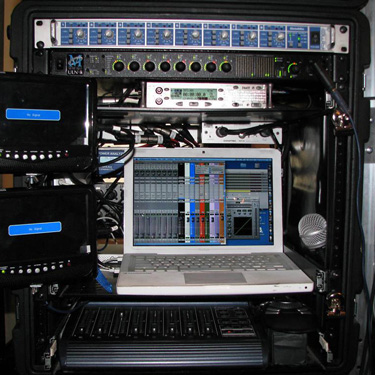|
 Graham Gardner's sound cart Graham Gardner's sound cart
NEW YORK, NEW YORK: For nearly a decade, Graham Gardner has been dutifully recording the on-location and on-set sound for both reality-based and scripted television shows in and around New York City. The business is fast-paced, and success is frequently measured not by the captured nuance of a subtle reverb tail, but by the reliable capture of intelligible spoken word. In reality-based work especially, there is no tolerance for a sound mixer’s request to “do that again!” But unlike many of his colleagues, Gardner has not abandoned the simple satisfaction of a sound well-recorded and, somewhat surprisingly, his clients are noticing the difference. Apart from technique, Gardner delivers a superior product with Metric Halo’s FireWire ULN-8 audio interface, which provides studio-grade mic preamps and AD/DA conversion, along with the DSP muscle to process and mix with efficiency and sonority.
“I love the sound of the Metric Halo ULN-8,” said Gardner. “There are only a few sound recorders that are manufactured specifically for the television and film industry, and I’ve found the ULN-8 to be more sonically transparent with a greater flexibility allowing me to both customize my workflow and deliver an excellent product. In addition, the Metric Halo ULN-8 has more IO and greater DSP capabilities than virtually any of the other recorders in its price point.”
Though billed as an “interface,” the Metric Halo ULN-8 is much more. It features eight boutique-quality mic preamps, eight 192 kHz A/D converters, eight 192 kHz D/A converters, headphone output, and a powerful DSP engine. The DSP provides instantiable processing on any input or output, along with a full-blown, fully-matrixable mixer accessed via the virtual “MIO console.” The ULN-8 is also powered via DC allowing Gardner to conveniently run it off the 12v battery on his cart. “Typically, a sound mixer uses a high-quality mixer which then feeds the recorder. With the ULN-8, it’s all in one. I simply use a control surface to ride the faders.”
Gardner recently finished work for the Wildheart Group, which is producing On Record: The Soundtrack of Our Lives, a documentary exploring the cultural impacts of recorded music. “I recorded an interview with an artist, who alternated between responding to questions and playing the piano,” recalled Gardner. “With just a standard recorder, I would have missed the depth and vibrancy of the piano. Of course, the same is true of spoken word; though we’re less able to consciously differentiate a stellar recording of spoken word from one that is just pretty good. Nevertheless, that difference is still there, and we do pick up on it.” In addition, Gardner was on hand to record several other artists. He documented recording sessions at Electric Lady Studios with engineer Craig White, who also is impressed with the sound of the ULN-8.
“A month later, the response from the head of the postproduction team was that after 1,100 hours of interviews, some three hundred people and performances, I had delivered the best sound in the lot,” remarked Gardner. “In the film and TV worlds, it is rare to receive a mild complement, let alone such unabashed praise. I attribute a great share of that success to Metric Halo.” Gardner is the first call when the project returns to New York City for further interviews. He has used the Metric Halo ULN-8 on his past four features, the last of which is a "Farrelly/Wessler movie" currently in production.
But as happy as everyone is with the sound that Gardner is able to deliver, the pressure to provide consistent results, even under stressful situations, remains paramount. His Metric Halo-based cart serves that critical requirement with elegance. “The Metric Halo rig is very compact,” explained Gardner. “With all the DSP capabilities of the ULN-8, I am able to do away with an analog mixer. All I need is an input, the ULN-8, a FireWire cable, a computer and headphones. The MIO console handles all of the routing and provides the jumping-off point for processing individual channels. I can also save and load particular arrangements of the mixer, which saves a lot of time and prevents mistakes that commonly occur with manual mixers.” |